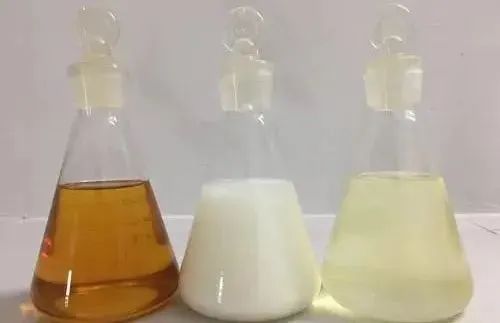In the cutting process, the rational use of cutting fluid can reduce the friction between the tool and the chip, the tool and the machined surface, reduce the cutting force and cutting temperature, reduce the tool wear, and improve the quality of the machined surface. Additives are often added to improve various properties of cutting fluids.

The additives commonly used in cutting fluids are as follows: 1. Oily and extreme pressure additives Oil-based additives are mainly used in low-pressure and low-temperature boundary lubrication conditions, and they mainly play the role of penetration and lubrication in the metal cutting process; while extreme pressure additives are organic compounds containing sulfur, phosphorus, chlorine, iodine, etc., which interact with metal surfaces at high temperatures. It acts as a chemical reaction to generate a chemical adsorption film, which can prevent the direct contact of the metal friction interface in the state of extreme pressure lubrication, reduce friction and maintain lubrication. 2. Anti-rust additives Commonly used anti-rust additives can be divided into two categories: water-soluble and oil-soluble. In order to prevent machine tools, tools and workpieces from being corroded during use, anti-rust additives should be added to the cutting fluid. It is a very polar compound and has strong adhesion to the metal surface. It preferentially adsorbs on the metal surface to form a protective film, or combines with the metal surface to form a passivation film to protect the metal surface from contact with corrosive media. Thus play a role in rust prevention. 3. Anti-mold additives Because the emulsion is easy to deteriorate and stink after long-term use, which is the result of bacterial reproduction. As long as a few ten thousandths of anti-mildew additives are added, the effect of sterilization and inhibition of bacterial reproduction can be achieved. (But the anti-mildew additive will cause erythema and itching of the operator's skin, so it is generally not used.) 4. Anti-foaming additives Anti-rust additives, emulsifiers and other surfactants will be added to the cutting fluid during use, which increases the possibility that these substances will be mixed with air and form foam. If there is too much foam, the effect of the cutting fluid will be reduced; anti-foaming Additives (such as dimethicone) can effectively prevent the formation of foam, so an appropriate amount of Anti-foaming Agent must be added to the grinding fluid, and a defoaming test must be performed. 5. Emulsifier additives Emulsion is the key material for emulsification of mineral oil and water to form a stable emulsion. It can be adsorbed on the oil-water interface to form a firm adsorption film, so that the oil is evenly dispersed in the water to form a stable emulsion. The dangers of misuse of additives Any operation has its operating rules, especially due to improper operation will cause certain harm, cutting fluid needs more attention, the fundamental harm of improper use of additives includes the harm to the human body itself, as well as the harm to the machine tool and many more. Hazard: During the use of additives, if the additives are used incorrectly, the most direct manifestation is that the stability of the prepared cutting fluid is not good, resulting in the cutting fluid not reaching the expected effect, increasing the cost of chemical operations, and damaging the life of the tool. common problem: 1. Foam: Improper use of additives will cause the water quality to soften to a certain extent. It is necessary to reduce the air pressure or reduce the flow rate of the cutting fluid, etc. 3. Corrosion: This happens due to insufficient corrosion resistance of the cutting fluid or insufficient concentration of the cutting fluid. 4. Stinking bacteria: The cutting fluid contains many additives of P and S. There is bacterial invasion during the configuration process, and the PH value of the cutting fluid is too low, which will cause the cutting fluid to stink and grow bacteria. In addition, there will be a series of problems such as emulsion stability problems, skin problems, workpieces, machine stickiness, oil pollution and so on.

![]() July 29, 2022
July 29, 2022




